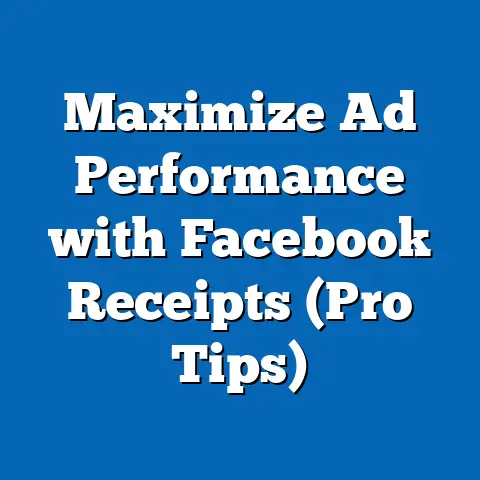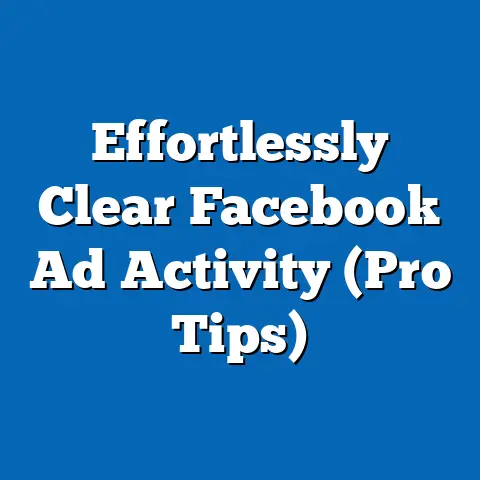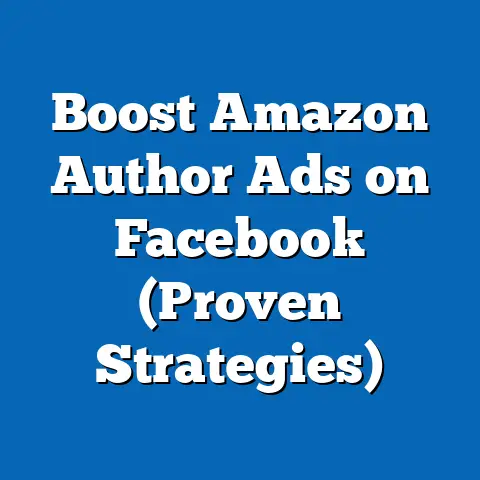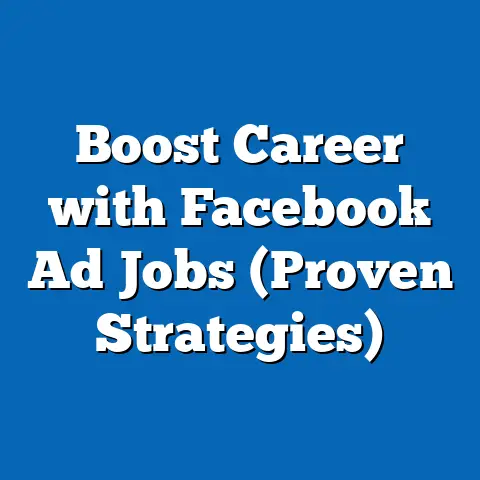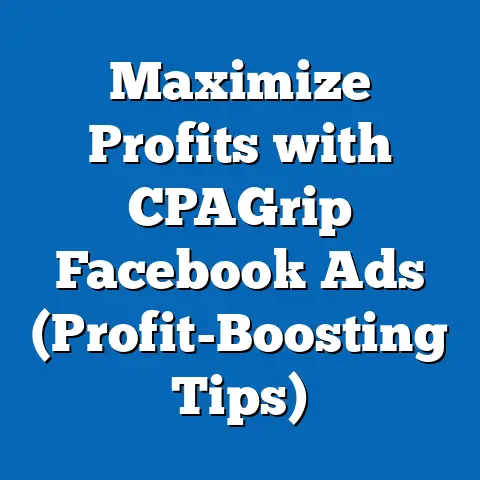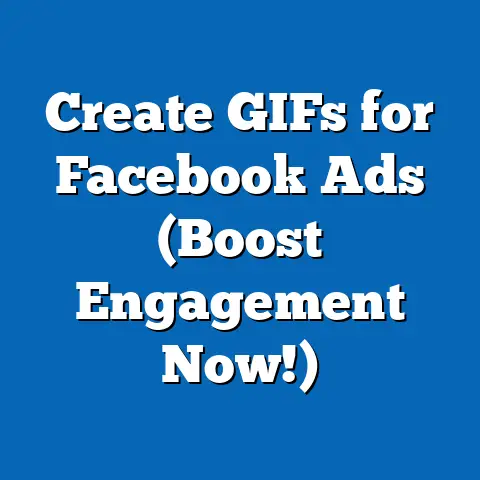Maximize Clicks with Facebook Ad Specs (Proven Strategies)
Have you ever spent hours crafting what you thought was the perfect Facebook ad, meticulously choosing the right image, writing compelling copy, and setting up precise targeting, only to find that it didn’t perform as well as you’d hoped? I know I have. It’s frustrating! In my early days of running Facebook ads, I was so focused on the creative aspect that I completely overlooked the technical specifications. The result? Blurry images, truncated text, and ultimately, a lackluster click-through rate.
Understanding Facebook Ad Specs
Facebook ad specs are the specific technical requirements that your ad creative must meet to display correctly on the platform. These specs cover everything from image and video dimensions to file sizes and text limits. They exist for a reason: to ensure a consistent and high-quality user experience across Facebook and its related platforms, including Instagram, Messenger, and Audience Network.
Why are they so crucial? Imagine seeing an ad with a pixelated image or text that’s cut off. It looks unprofessional, right? It diminishes your brand’s credibility and makes users less likely to click. By adhering to Facebook’s ad specs, you ensure that your ads look their best, capture attention effectively, and provide a seamless experience for potential customers.
Different Ad Formats and Their Specifications
Facebook offers a variety of ad formats to suit different marketing objectives, each with its own set of specifications. Here’s a breakdown of some of the most common:
-
Image Ads: These are the simplest form of Facebook ads, featuring a single image or video with accompanying text.
- Image Dimensions: The recommended size is 1200 x 628 pixels. Using this size ensures your image looks crisp and clear on most devices.
- Aspect Ratio: Aim for a 1.91:1 aspect ratio.
- File Size: Keep your image file size below 30MB.
- Text Limits:
- Headline: Up to 25 characters.
- Primary Text: Up to 125 characters.
- Description: Up to 30 characters.
-
Video Ads: Video ads are incredibly engaging and can be used to tell compelling stories or showcase your product in action.
- Video Dimensions: Recommended resolution is at least 1080 x 1080 pixels (square video).
- Aspect Ratio: Facebook supports various aspect ratios, including 1:1 (square), 4:5 (vertical), and 16:9 (horizontal).
- File Size: Keep your video file size below 4GB.
- Video Length: While Facebook allows videos up to 240 minutes long, shorter, more concise videos tend to perform better. I’ve found that videos between 15-60 seconds work best for initial engagement.
- Text Limits: Same as image ads.
-
Carousel Ads: Carousel ads allow you to showcase multiple images or videos within a single ad unit. This is great for highlighting different product features, telling a story, or showcasing a collection of items.
- Image Dimensions: 1080 x 1080 pixels (square).
- Video Dimensions: 1080 x 1080 pixels (square).
- Aspect Ratio: 1:1 (square).
- File Size: Images should be below 30MB, and videos should be below 4GB.
- Text Limits (Per Card):
- Headline: Up to 40 characters.
- Description: Up to 20 characters (optional).
-
Slideshow Ads: Slideshow ads combine multiple images or videos into a single video-like format. They’re a great way to create engaging content without the need for a fully produced video.
- Image Dimensions: 1280 x 720 pixels (recommended).
- Aspect Ratio: 16:9, 1:1, or 2:3.
- File Size: Keep individual image files below 30MB.
- Video Length: The total slideshow length can vary, but shorter slideshows tend to perform better.
- Text Limits: Same as image ads.
Image Ads: These are the simplest form of Facebook ads, featuring a single image or video with accompanying text.
- Image Dimensions: The recommended size is 1200 x 628 pixels. Using this size ensures your image looks crisp and clear on most devices.
- Aspect Ratio: Aim for a 1.91:1 aspect ratio.
- File Size: Keep your image file size below 30MB.
- Text Limits:
- Headline: Up to 25 characters.
- Primary Text: Up to 125 characters.
- Description: Up to 30 characters.
- Headline: Up to 25 characters.
- Primary Text: Up to 125 characters.
- Description: Up to 30 characters.
Video Ads: Video ads are incredibly engaging and can be used to tell compelling stories or showcase your product in action.
- Video Dimensions: Recommended resolution is at least 1080 x 1080 pixels (square video).
- Aspect Ratio: Facebook supports various aspect ratios, including 1:1 (square), 4:5 (vertical), and 16:9 (horizontal).
- File Size: Keep your video file size below 4GB.
- Video Length: While Facebook allows videos up to 240 minutes long, shorter, more concise videos tend to perform better. I’ve found that videos between 15-60 seconds work best for initial engagement.
- Text Limits: Same as image ads.
Carousel Ads: Carousel ads allow you to showcase multiple images or videos within a single ad unit. This is great for highlighting different product features, telling a story, or showcasing a collection of items.
- Image Dimensions: 1080 x 1080 pixels (square).
- Video Dimensions: 1080 x 1080 pixels (square).
- Aspect Ratio: 1:1 (square).
- File Size: Images should be below 30MB, and videos should be below 4GB.
- Text Limits (Per Card):
- Headline: Up to 40 characters.
- Description: Up to 20 characters (optional).
- Headline: Up to 40 characters.
- Description: Up to 20 characters (optional).
Slideshow Ads: Slideshow ads combine multiple images or videos into a single video-like format. They’re a great way to create engaging content without the need for a fully produced video.
- Image Dimensions: 1280 x 720 pixels (recommended).
- Aspect Ratio: 16:9, 1:1, or 2:3.
- File Size: Keep individual image files below 30MB.
- Video Length: The total slideshow length can vary, but shorter slideshows tend to perform better.
- Text Limits: Same as image ads.
Takeaway: Understanding the specific requirements for each ad format is the first step towards creating high-performing ads. Make sure to consult Facebook’s official documentation for the most up-to-date specs.
The Importance of Visuals in Facebook Ads
In the fast-paced world of social media, visuals reign supreme. People scroll through their feeds quickly, and you have only a few seconds to grab their attention. That’s why the visual elements of your Facebook ads are so critical.
According to Facebook, ads with images or videos can increase engagement by up to 40%. This underscores the importance of using high-quality, eye-catching visuals that resonate with your target audience.
Optimal Image and Video Specifications
To make the most of your visuals, it’s essential to adhere to Facebook’s recommended specifications:
- Image Resolution: Always use high-resolution images. Blurry or pixelated images look unprofessional and can deter users from clicking. Aim for at least 1200 x 628 pixels for standard image ads.
- Video Resolution: For video ads, aim for a resolution of at least 1080 x 1080 pixels. This ensures your video looks crisp and clear on all devices.
- Aspect Ratio: Choose the right aspect ratio for your ad format. Square videos (1:1) tend to perform well on mobile devices, while horizontal videos (16:9) are better suited for desktop displays.
- File Size: Keep your file sizes as small as possible without sacrificing quality. Large files can slow down loading times, which can negatively impact user experience and ad performance.
- Color and Contrast: Use colors and contrast to your advantage. Bright, contrasting colors can help your ad stand out in a crowded news feed.
Strategies for Creating Eye-Catching Visuals
Beyond adhering to specifications, here are some proven strategies for creating visuals that capture attention and drive clicks:
- Use High-Quality Images: This might seem obvious, but it’s worth repeating. Invest in professional photography or use high-quality stock photos to ensure your images look their best. There are numerous free stock photo sites like Unsplash and Pexels that offer stunning images you can use without breaking the bank.
- Minimize Text Overlay: While Facebook used to have a strict 20% text rule on images, they’ve since relaxed this policy. However, it’s still a good idea to minimize the amount of text on your images. Too much text can make your ad look cluttered and overwhelming.
- Showcase Your Product: If you’re selling a product, showcase it in action. Use images or videos that demonstrate how your product solves a problem or improves people’s lives.
- Use Faces: Human faces are naturally engaging. Consider using images or videos that feature people interacting with your product or service.
- Tell a Story: Visuals are a powerful way to tell a story. Use a series of images or a short video to convey a message that resonates with your target audience.
- Keep it Simple: Don’t try to cram too much into a single image or video. Keep your visuals clean, simple, and easy to understand. I’ve found that focusing on one key message or benefit is often more effective than trying to communicate too much at once.
Example: I once ran a campaign for a local coffee shop. Instead of just using a generic picture of a coffee cup, we created a short video showcasing the barista crafting a latte, complete with latte art. The video was visually appealing, told a story about the craftsmanship of the coffee shop, and ultimately drove a significant increase in foot traffic.
Takeaway: Invest time and effort into creating high-quality visuals that adhere to Facebook’s specifications. Your visuals are often the first thing people see, so make sure they make a positive impression.
Crafting Compelling Ad Copy
While visuals are crucial for capturing attention, compelling ad copy is what ultimately convinces people to click. Your ad copy should be concise, engaging, and relevant to your target audience. It should clearly communicate the value proposition of your product or service and include a strong call to action.
Understanding Text Requirements
Facebook ad specs extend beyond visuals to include specific text requirements for the headline, primary text, and description. Here’s a quick recap:
- Headline: Up to 25 characters.
- Primary Text: Up to 125 characters.
- Description: Up to 30 characters.
These character limits can be challenging, but they force you to be concise and focus on the most important information.
Strategies for Writing Effective Ad Copy
Here are some strategies for writing compelling ad copy that adheres to character limits while still delivering a strong message:
- Know Your Audience: Before you start writing, take the time to understand your target audience. What are their pain points? What are their aspirations? Use this knowledge to craft copy that speaks directly to their needs and desires.
- Highlight the Benefits: Focus on the benefits of your product or service, not just the features. Explain how it will solve a problem, improve their lives, or make them happier.
- Use Strong Verbs: Use strong, action-oriented verbs that encourage people to click. Examples include “Shop Now,” “Learn More,” “Get Started,” and “Download Now.”
- Create a Sense of Urgency: Create a sense of urgency to encourage people to act quickly. Use phrases like “Limited Time Offer,” “Sale Ends Soon,” or “Don’t Miss Out.”
- Use Social Proof: If you have positive reviews or testimonials, include them in your ad copy. Social proof can be a powerful way to build trust and credibility.
- Test Different Variations: Don’t be afraid to experiment with different variations of your ad copy. A/B testing can help you identify which headlines, primary text, and descriptions resonate best with your target audience.
Examples of Effective Ad Copy
Let’s look at some examples of effective ad copy and analyze what makes them work:
Example 1: E-commerce Store Selling Shoes
- Headline: New Arrivals!
- Primary Text: Step into style with our latest collection of shoes! Shop now and find the perfect pair for any occasion. Limited time offer: Get 20% off your first order!
- Description: Shop Now & Save
Analysis: This ad copy is concise, highlights the benefit of new arrivals, creates a sense of urgency with the limited-time offer, and includes a clear call to action.
Example 2: SaaS Company Offering Project Management Software
- Headline: Streamline Your Projects
- Primary Text: Tired of juggling multiple tools and missed deadlines? Our project management software helps you stay organized, collaborate effectively, and deliver projects on time. Try it free for 14 days!
- Description: Start Your Free Trial
Analysis: This ad copy addresses a common pain point (juggling multiple tools), highlights the benefits of the software (staying organized, collaborating effectively), and includes a compelling call to action (start a free trial).
Example 3: Local Restaurant Promoting a Special Deal
- Headline: Pizza Night!
- Primary Text: Craving delicious pizza? Get 50% off all pizzas tonight only! Order online or call us to place your order.
- Description: Order Now & Save
Analysis: This ad copy is simple, direct, and creates a sense of urgency with the “tonight only” offer. It also includes clear instructions on how to order.
Takeaway: Crafting compelling ad copy is an art and a science. By understanding your audience, highlighting the benefits of your product or service, and using strong calls to action, you can create ads that drive clicks and conversions.
Targeting the Right Audience
Even the most visually appealing ads with the most compelling copy will fall flat if they’re not shown to the right people. That’s why targeting is such a crucial component of Facebook advertising. Facebook’s powerful targeting options allow you to reach specific audiences based on demographics, interests, behaviors, and more.
Overview of Facebook Targeting Options
Here’s a breakdown of some of the most common Facebook targeting options:
- Demographics: Target users based on age, gender, location, education, job title, and more.
- Interests: Target users based on their interests, hobbies, and the pages they’ve liked on Facebook.
- Behaviors: Target users based on their online and offline behaviors, such as purchase history, device usage, and travel habits.
- Custom Audiences: Create custom audiences based on your existing customer data, such as email lists, website visitors, and app users.
- Lookalike Audiences: Expand your reach by creating lookalike audiences, which are similar to your existing customers.
Utilizing Ad Specs to Refine Audience Reach
While ad specs primarily focus on the technical aspects of your ad creative, they can also indirectly help you refine your audience reach. Here’s how:
- Ad Format Optimization: By choosing the right ad format for your target audience, you can improve engagement and click-through rates. For example, if you’re targeting a younger audience, video ads or carousel ads might be more effective than static image ads.
- Visual Relevance: Use visuals that resonate with your target audience. For example, if you’re targeting outdoor enthusiasts, use images or videos that showcase your product in an outdoor setting.
- Copy Localization: Tailor your ad copy to the language and cultural nuances of your target audience. This can significantly improve engagement and click-through rates.
Case Studies: Precise Targeting and Ad Specs
Here are some case studies that illustrate how precise targeting combined with adherence to ad specs can lead to increased engagement and click-through rates:
Case Study 1: Local Gym Targeting New Year’s Resolutioners
- Targeting:
- Demographics: Age 25-45, located within 5 miles of the gym.
- Interests: Fitness, weight loss, healthy eating.
- Behaviors: Recently expressed interest in starting a new fitness routine.
- Ad Specs:
- Format: Video ad showcasing the gym’s facilities and trainers.
- Visuals: High-quality video with upbeat music and testimonials from satisfied members.
- Copy: “Kickstart your New Year’s resolution with our expert trainers and state-of-the-art facilities! Sign up for a free consultation today.”
- Results: The gym saw a 30% increase in new memberships in January compared to the previous year.
- Demographics: Age 25-45, located within 5 miles of the gym.
- Interests: Fitness, weight loss, healthy eating.
- Behaviors: Recently expressed interest in starting a new fitness routine.
- Format: Video ad showcasing the gym’s facilities and trainers.
- Visuals: High-quality video with upbeat music and testimonials from satisfied members.
- Copy: “Kickstart your New Year’s resolution with our expert trainers and state-of-the-art facilities! Sign up for a free consultation today.”
Case Study 2: Online Clothing Store Targeting Fashion-Conscious Millennials
- Targeting:
- Demographics: Age 18-34, interested in fashion, style, and online shopping.
- Interests: Specific clothing brands, fashion bloggers, and influencers.
- Behaviors: Frequent online shoppers, engaged with fashion-related content on Facebook and Instagram.
- Ad Specs:
- Format: Carousel ad showcasing multiple items from their latest collection.
- Visuals: High-quality images with a consistent aesthetic and minimal text overlay.
- Copy: “Discover our latest collection of must-have styles! Shop now and elevate your wardrobe.”
- Results: The clothing store saw a 25% increase in website traffic and a 15% increase in online sales.
- Demographics: Age 18-34, interested in fashion, style, and online shopping.
- Interests: Specific clothing brands, fashion bloggers, and influencers.
- Behaviors: Frequent online shoppers, engaged with fashion-related content on Facebook and Instagram.
- Format: Carousel ad showcasing multiple items from their latest collection.
- Visuals: High-quality images with a consistent aesthetic and minimal text overlay.
- Copy: “Discover our latest collection of must-have styles! Shop now and elevate your wardrobe.”
Takeaway: Targeting the right audience is just as important as creating visually appealing ads with compelling copy. By combining precise targeting with adherence to ad specs, you can maximize engagement and drive conversions.
Testing and Optimization
Even if you’ve followed all the best practices and created what you believe to be the perfect Facebook ad, it’s essential to test and optimize your campaigns to ensure they’re performing at their best. A/B testing allows you to compare different variations of your ads and identify which elements resonate most with your target audience.
Setting Up A/B Tests
Here’s how to set up A/B tests for different variations of ad specs:
- Choose a Variable: Select a specific element of your ad that you want to test, such as the headline, primary text, image, or call to action.
- Create Variations: Create two or more variations of your ad, each with a different version of the variable you’re testing. For example, you might test two different headlines or two different images.
- Set Up Your Test: Use Facebook’s A/B testing feature to set up your test. This feature allows you to split your audience and show each variation of your ad to a different segment of your target audience.
- Run Your Test: Run your test for a sufficient amount of time to gather statistically significant data. Facebook recommends running your test for at least 4-7 days.
- Analyze the Results: Once your test is complete, analyze the results to determine which variation performed best. Look at metrics such as click-through rate, conversion rate, and cost per acquisition.
- Implement the Winning Variation: Implement the winning variation in your ad campaigns.
Actionable Strategies for Ongoing Optimization
Here are some actionable strategies for ongoing optimization based on performance metrics:
- Monitor Your Metrics: Regularly monitor your key performance indicators (KPIs), such as click-through rate, conversion rate, and cost per acquisition.
- Identify Trends: Look for trends in your data. Are certain ad formats performing better than others? Are certain targeting options more effective?
- Adjust Your Bids: Adjust your bids based on performance. If an ad is performing well, increase your bids to reach a larger audience. If an ad is underperforming, decrease your bids or pause the ad altogether.
- Refine Your Targeting: Continuously refine your targeting options based on performance data. Exclude audiences that are not converting and focus on audiences that are.
- Update Your Creative: Regularly update your ad creative to keep it fresh and engaging. Use new images, videos, and ad copy to prevent ad fatigue.
Example: I once ran an A/B test for a client selling online courses. We tested two different headlines: “Learn New Skills Online” and “Unlock Your Potential.” The “Unlock Your Potential” headline significantly outperformed the “Learn New Skills Online” headline, resulting in a 20% increase in click-through rate. We immediately implemented the winning headline in all of our ad campaigns, resulting in a significant increase in leads and sales.
Takeaway: Testing and optimization are essential for maximizing the performance of your Facebook ad campaigns. By continuously testing different variations of your ads and analyzing the results, you can identify what works best and optimize your campaigns for maximum ROI.
Staying Updated with Facebook’s Guidelines
The world of Facebook advertising is constantly evolving. Facebook regularly updates its ad specs, policies, and best practices. It’s essential to stay informed about these changes to ensure your ads are compliant and performing at their best.
Resources for Keeping Up-to-Date
Here are some resources for keeping up-to-date with Facebook’s guidelines:
- Facebook Business Help Center: The Facebook Business Help Center is the official source for information about Facebook advertising. It includes detailed documentation about ad specs, policies, and best practices.
- Facebook Marketing Partners: Facebook Marketing Partners are third-party companies that have been vetted by Facebook and offer a range of services to help businesses succeed on the platform. Many Marketing Partners offer webinars, blog posts, and other resources to help you stay informed about the latest changes.
- Industry Blogs and Newsletters: Subscribe to industry blogs and newsletters that cover Facebook advertising. These resources can provide valuable insights and analysis of the latest trends and changes.
- Facebook’s Newsroom: Keep an eye on Facebook’s Newsroom for announcements about new features, policies, and updates.
- Online Communities: Join online communities and forums where marketers discuss Facebook advertising. These communities can be a great way to learn from others and stay informed about the latest changes. I personally participate in several Facebook groups dedicated to digital marketing and find them incredibly valuable for staying current.
Gaining a Competitive Edge
By staying proactive about Facebook’s updates, you can gain a competitive edge. Here’s how:
- Compliance: Ensuring your ads are compliant with Facebook’s policies can prevent ad disapprovals and account suspensions.
- Optimization: Understanding the latest ad specs and best practices can help you optimize your ads for maximum performance.
- Innovation: By staying informed about new features and updates, you can be among the first to experiment with them and gain a competitive advantage.
Example: When Facebook first introduced the “Advantage+” campaign budget, many advertisers were hesitant to adopt it. However, those who experimented with it early on were able to achieve significant improvements in performance and ROI.
Takeaway: Staying updated with Facebook’s guidelines is an ongoing process. By utilizing the resources mentioned above and staying proactive about learning, you can ensure your ads are compliant, optimized, and performing at their best.
Conclusion
Maximizing clicks on your Facebook ads isn’t just about having a great product or service; it’s about understanding and leveraging the platform’s ad specs to your advantage. By adhering to the correct image and video dimensions, crafting compelling ad copy that fits within the character limits, and targeting the right audience, you can significantly enhance your ad performance and drive more traffic to your desired destination.
Remember, Facebook advertising is an ongoing process of testing, optimization, and learning. Stay informed about the latest changes, experiment with different strategies, and continuously refine your campaigns to achieve your marketing goals.
Now go forth and create some amazing Facebook ads!

